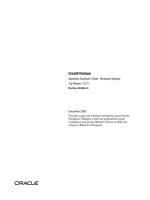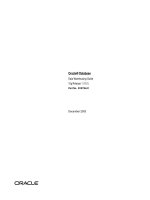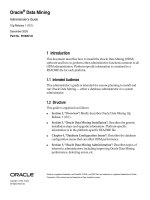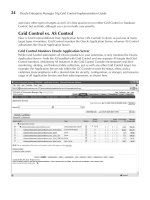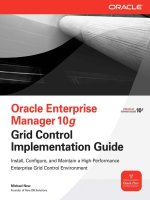Oracle 10g Data Mining Administrators Guide WW
Bạn đang xem bản rút gọn của tài liệu. Xem và tải ngay bản đầy đủ của tài liệu tại đây (209.39 KB, 24 trang )
Oracle
®
Data Mining
Administrator’s Guide
10g Release 1 (10.1)
December 2003
Part No. B10697-01
1Introduction
This document describes how to install the Oracle Data Mining (ODM)
software and how to perform other administrative functions common to all
ODM administration. Platform-specific information is contained in a
README file for each platform.
1.1 Intended Audience
This administrator’s guide is intended for anyone planning to install and
run Oracle Data Mining — either a database administrator or a system
administrator.
1.2 Structure
This guide is organized as follows:
■
Section 2, "Overview": Briefly describes Oracle Data Mining 10g
Release 1 (10.1) .
■
Section 3, "Oracle Data Mining Installation": Describes the generic
installation steps and upgrade information. Platform-specific
information is in the platform-specific README file.
■
Chapter 4, "Database Configuration Issues": Describes the database
configuration issues that can affect ODM performance.
■
Section 5, "Oracle Data Mining Administration": Describes topics of
interest to administrators, including improving Oracle Data Mining
performance, detecting errors, etc.
Oracle is a registered trademark, and Oracle9i, PL/SQL, and SQL*Plus are trademarks or registered trademarks of Oracle
Corporation. Other names may be trademarks of their respective owners.
Copyright 2003, Oracle.
All Rights Reserved.
2
■
Section 6, "ODM Native Model Export and Import": Describes using
the PL/SQL interface to perform Model Export and Import, including
requirements and restrictions.
■
Section 7, "Documentation Accessibility": Describes Oracle
documentation accessibility standards.
1.3 Where to Find Further Information
The documentation set for Oracle Data Mining is part of the Oracle10g
Database Documentation Library; the ODM document set consists of the
following documents:
■
Oracle Data Mining Administrator’s Guide, 10g Release 1 (10.1) (this
document). Includes generic installation information.
■
For platform-specific installation information, see the platform-specific
README files.
■
Oracle Database 10g Installation Guide for your platform.
■
Oracle Data Mining Concepts, 10g Release 1 (10.1) .
■
Oracle Data Mining Application Developer’s Guide, 10g Release 1 (10.1) .
For detailed information about the ODM Java API, see the ODM Javadoc in
the directory $ORACLE_HOME/dm/doc/odmjdoc.zip
(for Windows, %ORACLE_HOME%\dm\doc\odmjdoc.zip) on any system
where ODM is installed. To prepare the Javadoc for user access, unzip this
file so that users can display it in a browser.
1.3.1 Related Manuals
For more information about the Oracle database, see:
■
Oracle Database Administrator's Guide
■
README for your platform
■
Oracle Universal Installer Concepts Guide
■
Oracle Database Migration
■
PL/SQL Packages and Types Reference
1.4 Conventions
In this manual, Windows refers to the Windows 2000 and Windows XP
operating systems.
The SQL interface to Oracle is referred to as SQL. This interface is the
Oracle implementation of the SQL standard ANSI X3.135-1992, ISO
9075:1992, commonly referred to as the ANSI/ISO SQL standard or SQL92.
3
In examples, an implied carriage return occurs at the end of each line,
unless otherwise noted. You must press the Return key at the end of a line
of input.
2Overview
Oracle Data Mining (ODM) embeds data mining within the Oracle
database. The data never leaves the database — the data, data preparation,
model building, and model scoring results all remain in the database. This
enables Oracle to provide an infrastructure for application developers to
integrate data mining seamlessly with database applications.
Data mining functions such as model building, testing, and scoring are
provided via a Java API and a PL/SQL API.
Oracle Data Mining supports the following features:
■
For classification: Naive Bayes, Adaptive Bayes Networks, and Support
Vector Machines
■
For regression: Support Vector Machines
■
For clustering: k-means and O-Cluster
■
For association: A Priori
■
For attribute importance: Minimum Description Length (MDL)
■
For feature extraction: Non-Negative Matrix Factorization
■
For unstructured data mining: Text Mining
■
For sequence matching and annotation: BLAST
For detailed information about the classes that constitute the ODM Java
API, see the Javadoc descriptions of classes.
For detailed information about the subprograms and functions that
constitute the ODM PL/SQL API, see the PL/SQL Packages and Types
Reference.
Oracle Data Mining 10g Release 1 (10.1) has many new features. For details,
see Oracle Data Mining Concepts.
ODM 10g Release 1 (10.1) runs on Real Application Clusters (see
Section 3.4).
Oracle 10g Release 1 (10.1) supports multi-user configuration.
4
3 Oracle Data Mining Installation
This section specifies generic ODM requirements and provides a
description of the generic installation steps.
3.1 ODM Requirements
ODM is an option to Oracle Enterprise Edition. All the software that ODM
requires is included in the Enterprise Edition.
3.2 Installation Steps
This document provides the generic instructions for installing Oracle Data
Mining.
Before you install ODM, confirm that your system satisfies the software and
hardware requirements for Oracle Enterprise Edition, as described in the
README for your platform. You should also ensure that your system
contains enough space for the tables that you plan to use during data
mining.
There are three common cases for installing ODM:
■
Oracle and ODM are not installed on your system (Section 3.2.1).
■
Oracle9i release 1 (or earlier) is installed on your system (Section 3.2.2)
■
Oracle9i release 2 is installed on your system (Section 3.2.2)
To install ODM on an Oracle10g Real Application Cluster, see Section 3.4.
3.2.1 No Database Installed
If this is a first-time installation of ODM on a system where the current
release of Oracle is not installed, there are two basic ways to install the
Oracle Enterprise Edition:
1.
Create a database with the starter database (Section 3.2.1.1).
2.
Create a customized database, that is, do not use the starter database
(Section 3.2.1.2).
3.2.1.1 ODM Installation with a Starter Database Oracle provides a starter
database that automatically includes features that result in a highly effective
database that is easy to manage.
Follow these steps to install Oracle and ODM:
1.
Start Oracle Universal Installer (OUI). For details, see the Oracle
Universal Installer Concepts Guide. The OUI starts with a welcome screen
and prompts you through a series of steps. Follow the instructions, and
5
see the release notes for late-breaking information that may affect the
installation steps or your choices. After you have specified the source
and destination, continue with the following steps in OUI:
2.
Installation Types: Select the Enterprise Edition.
3.
Database Configuration: Select a configuration. If you are not sure
which configuration to choose, select "Create a starter database" and
select "General-purpose database", or see Section 3.2.1.2 for information
about installing ODM with a customized database.
4.
Database Configuration Options: Provide a global database name and a
SID, a database character set, and indicate whether you would like to
install example schemas.
5.
Database File Storage Options: Select File System or Automated Storage
Management or Raw Devices.
6.
Database File Location: If you choose File System, specify the file
location.
7.
Specify backup and recovery options.
8.
Specify database schema passwords.
9.
Select Database Management option.
10.
Summary: Presents a list of settings and products to be installed. Click
Install.
After successful installation, all ODM software is located in the $ORACLE_
HOME/dm (for Windows, %ORACLE_HOME%\dm) directory. Perform the
following post-installation steps:
1.
You may want to “unlock” the DMSYS account and change the default
passwords.
2.
Create a tablespace to be used by data mining users.
3.
You need at least one user account for data mining, with the
appropriate privileges set for that user.
■
To create a user account, go to$ORACLE_HOME/dm/admin (for
Windows, %ORACLE_HOME%\dm\admin) and run odmuser.sql.
■
If you already have a user account for data mining, make sure that
the user has the privileges specified in the SQL script
odmuser.sql.
4.
Edit your init.ora file to set a value for utl_file_dir initialization
parameter. The value should be the path name of a directory that the
database can write to.
6
3.2.1.2 ODM Installation with a Customized Database Installing and creating a
customized database involves more steps than creating a starter database,
but gives you full control to specify database components that you wish to
install.
These are the major steps required to install ODM without using a starter
database:
1.
Install Oracle Enterprise Edition and create a customized database. See
Section 3.2.3 for information about recommended database parameter
settings for running ODM and Section 4 about tuning your database for
improved performance.
2.
Run the Oracle Database Configuration Assistant (DBCA) utility to
install the ODM option; DBCA is described in the Oracle Database
Administrator’s Guide. You will have the option of selecting the ODM
Scoring Engine
After successful installation, all ODM software is located in the $ORACLE_
HOME/dm (for Windows, %ORACLE_HOME%\dm) directory.
In order to run ODM sample programs, certain data sets need to be loaded
into the ODM user account. The loading script is at
$ORACLE_HOME/dm/admin/dmuserld.sql
(for Windows, %ORACLE_HOME%\dm\admin\dmuserld.sql).
3.2.2 Upgrade from Oracle9i Releases
If Oracle9i Release 1 (9.0.1) or Release 2 (9.2.0) with the ODM option is
installed on your system, you can choose to upgrade your system to the
current release. ODM is upgraded as part of the database upgrade process.
For detailed information about upgrading the database, see Oracle Database
Migration. For information about upgrading ODM, see Section 3.6.
3.2.3 Database Initialization Parameters for Oracle Data Mining
The default values of initialization parameters in an Oracle starter database
are generally sufficient for running ODM.
Make sure that job_queue_processes is set to a value appropriate for
your application (a minimum of 2).
The parameter utl_file_dir must be set to a directory path specific to
your site.
7
3.3 Verifying ODM Installation
Oracle10g Data Mining is an option to the Oracle10g Enterprise Edition. If
ODM is part of your installation, the following query should return a value
of TRUE:
SELECT value
FROM v$option
WHERE parameter = ’Oracle Data Mining’;
This query is usually run by the DBA logged in as dba.
3.4 ODM Installation on a Real Application Cluster
ODM installation on a Real Application Cluster (RAC) is similar to ODM
installation on a non-RAC system. If you use Oracle Universal Installer to
create the preconfigured database on RAC, ODM will be installed in this
database just as it is in a non-RAC environment.
If you choose to create a customized database on your Real Application
Cluster (RAC) and install ODM there, we recommend that you configure
the ODM tablespace with a raw device partition of at least 250 MB.
3.5 Data Mining Scoring Engine Installation
Data Mining Scoring Engine is a custom installation option for Oracle Data
Mining. Select this option to install the ODM Scoring Engine as an
alternative to installing Oracle Data Mining.
For more information about the Oracle Data Mining Scoring Engine, see
Oracle Data Mining Concepts.
3.6 Upgrading ODM
ODM upgrade is part of the Oracle RDBMS 9.2.0 to 10.1.0 upgrade process.
When the database server upgrade completes, ODM is upgraded to the
10.1.0 release level.
In order to upgrade ODM 9.2.0 to ODM 10.1 release, you must upgrade
your RDBMS to the latest RDBMS 9.2.0.4 patch set release level before
starting the migration from 9.2 to 10.1. ODM is part of the RDBMS 9.2.0.4
patch set release. For detailed information about upgrading an Oracle
database, see the Oracle Database Migration manual.
8
3.6.1 ODM Schema Object Upgrade
There are major schema changes between ODM 9.2 and the current release.
These changes are required to fully support the ODM multi-user
environment and to implement Oracle Advanced Security features.
In ODM 9.2, there were two ODM-required database schemas, namely,
ODM and ODM_MTR. In the current release, these two schemas have been
upgraded to DMSYS and the DM user schema (the former ODM schema).
The DMSYS schema is the ODM repository, which contains data mining
metadata. ODM schema becomes the DM user schema that holds user input
and output/result data sets. Customers can choose to either use the
upgraded ODM schema or create one or more data mining user schema(s)
to perform data mining activities.
When you upgrade to the current release, the existing ODM 9.2 data mining
models, settings, and results are upgraded to the current release format.
Customers can continue to conduct various data mining activities using
objects upgraded from the 9.2 release. There are schema definition changes
in the current release schema.
New objects created in the ODM 10.1 environment are subject to a naming
restriction, that is, names of objects must be 25 bytes or less. This restriction
applies across DM user database schemas. However, after upgrading, 9.2
object names (models, settings, and results) are retained in the current
release environment. It is recommended that users follow the new ODM
naming convention when creating objects in the future.
In the 9.2 release, all mining activities are conducted through the ODM
schema (with definer’s rights). In the current release, data mining activities
are performed in the DM user schema (with invoker’s rights). In an
upgraded ODM environment, the ODM schema has been upgraded from a
definer’s schema to an invoker’s schema.
If necessary, ODM schema objects can be downgraded to the 9.2.0.4 final
patch set release.
3.6.2 Category Data Type in 9.2 and in the Current Release
In ODM 9.2, we did not store category data type in the dm_category_
matrix_entry table. In the current release, we do store data type. In
migrating from 9.2 to the current release, this results in all categories
restored having a string data type, no matter what the actual data type.
9
3.7 Sample Programs for Oracle Data Mining
The directory $ORACLE_HOME/dm/demo/sample (on UNIX) or %ORACLE_
HOME%\dm\demo\sample (on Windows) contains sample programs for
ODM. This directory contains the following subdirectories:
■
java — contains ODM sample programs illustrating the Java API.
Property-based ODM Java sample programs are removed from the
product shipment in 10g. They are downloadable from OTN.
■
plsql — contains ODM sample programs illustrating the use of the
ODM PL/SQL packages DBMS_DATA_MINING and DBMS_DATA_
MINING_TRANSFORMS (in the PL/SQL Packages and Types Reference.
The directory plsql contains a subdirectory utl; contains sample
programs illustrating how to export and import ODM models.
The data used by all the sample programs is in $ORACLE_
HOME/dm/demo/data on Unix or %ORACLE_HOME%\dm\demo\data on
Windows. ODM sample data sets need to be loaded into a user schema
prior to using the sample programs. Refer to the following scripts for
creating Oracle tablespace, user schema, and loading ODM sample data
sets:
$ORACLE_HOME/dm/admin/odmtbs.sql
$ORACLE_HOME/dm/admin/odmuser.sql
$ORACLE_HOME/dm/admin/dmuserld.sql
3.7.1 ODM Sample Programs Using Oracle Common Schema (Sales
History)
For 10g, ODM Java and PL/SQL sample programs also use datasets
shipped with Oracle Common Schema (SH). In order to use the datasets,
the Sample schema SH must be installed by a site DBA in the target
database.
The following table objects in SH schema are referenced by DM Sample
programs:
sh.sales
sh.customers
sh.products
sh.supplementary_demographics
sh.countries
The following scripts need to be executed by the site DBA. The scripts grant
necessary SH access privileges and create related DM objects prior to
running DM sample programs that reference SH schema objects:
$ORACLE_HOME/dm/admin/dmshgrants.sql
$ORACLE_HOME/dm/admin/dmsh.sql

